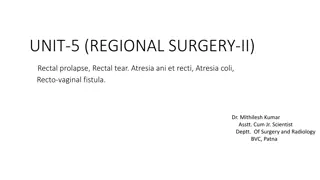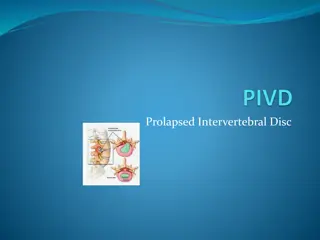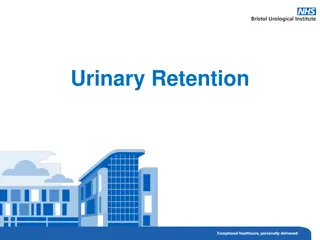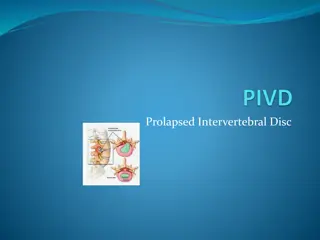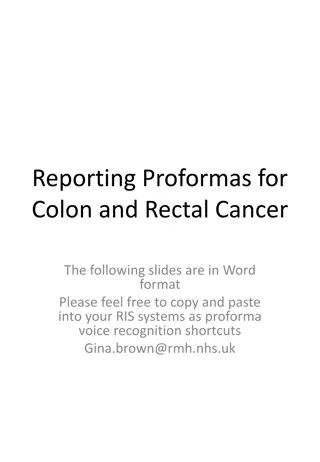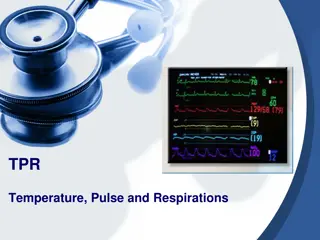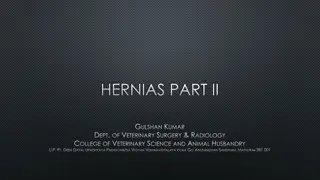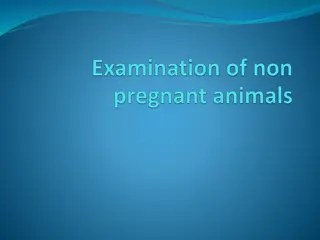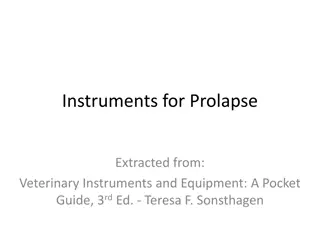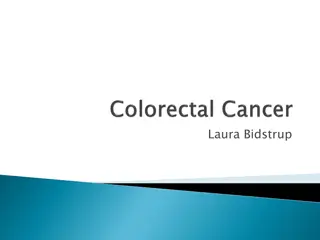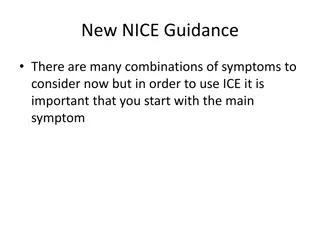Rectal Prolapse and Rectal Tears in Animals: Causes and Treatments
Rectal prolapse and rectal tears are common conditions observed in cattle, buffaloes, and small ruminants. Prolonged tenesmus, increased intraabdominal pressure, rectal inflammation, and other factors contribute to the development of these issues. Early diagnosis and treatment are crucial to prevent
2 views • 34 slides
Understanding Prolapsed Intervertebral Disc (PIVD)
The intervertebral disc, a crucial component of the spine, can be affected by prolapse, leading to various stages of PIVD. The condition involves the nucleus pulposus bulging out due to tears in the annulus fibrosis. The stages of PIVD include bulging disc, protrusion, extrusion, and sequestrization
0 views • 36 slides
Understanding Urinary Retention: Causes, Symptoms, and Management
Urinary retention can be acute or chronic, resulting in the painful inability to void or fully empty the bladder. In men, common causes include benign prostatic enlargement and post-surgery complications, while women may experience it due to pelvic prolapse or neurological issues. Initial management
3 views • 13 slides
Understanding Suppositories: Types, Preparation, and Mold Calibration
Suppositories are solid dosage forms designed for insertion into vaginal or rectal cavities. They can melt, soften, or dissolve to provide localized or systemic effects. Learn about the types of suppository bases, preparation methods, mold calibration, and displacement value calculation in supposito
0 views • 27 slides
Viral Specimen Selection and Collection Overview
Specimen selection for viral testing depends on the suspected viral etiologies and disease syndrome. Throat and nasopharyngeal swabs are used for different viruses, while rectal swabs, urine, blood, and tissue samples are also collected for specific viral detection. Proper specimen transport and sto
0 views • 7 slides
Understanding Prolapsed Intervertebral Disc (PIVD) and its Stages
The article explores the anatomy of intervertebral discs, definition of spinal disc prolapse, stages of PIVD (bulging disc, protrusion, extrusion, sequestration), and provides detailed insights into each stage with corresponding images. Readers can gain a comprehensive understanding of PIVD and its
0 views • 36 slides
Understanding Anorectal Malformations in Pediatric Surgery
Anorectal malformations are congenital abnormalities involving the development of the anal canal and sphincter muscles. They may present with imperforate anus, fistulous connections, or rectal atresia. Classification in males and females helps in determining the types of surgical treatments required
0 views • 15 slides
Laboratory Related CRFs for Pharmacokinetics Study
This collection encompasses various CRFs related to laboratory procedures in the context of Pharmacokinetics for a study. It includes forms for enrollment, specimen storage, safety laboratory results, and specific days for sample collection. The CRFs detail the storage, collection, and documentation
0 views • 14 slides
Insights into Structured Reporting Practices in Colorectal Cancer Imaging
A survey conducted by Dr. Eric Loveday at North Bristol NHS Trust revealed the current landscape of structured reporting in MRI and CT scans for rectal and colon cancer. Results indicate a positive outlook towards implementing national standards for structured radiology reporting, with an emphasis o
0 views • 7 slides
Dr. Julie Oliver - Transforming Women's Health Care: A Community Approach
Dr. Julie Oliver, a GP at Lanchester Medical Centre, initiated a community women's health clinic in 2002 with a focus on complex gynaecology services. The clinic offers specialized care such as managing heavy periods, menopause, prolapse, and more, following a one-stop shop model for efficient patie
0 views • 18 slides
Comparison of Surgical Resection vs. Organ Preservation after Neoadjuvant Chemoradiotherapy for Rectal Cancer
In the management of rectal cancer, the debate between surgical resection and organ preservation after neoadjuvant chemoradiotherapy is ongoing. While surgical resection is highly effective, the watch-and-wait strategy offers benefits such as avoiding permanent stomas and improving quality of life.
1 views • 14 slides
Understanding Torticollis, Prolapse, and Infection in Infants
Torticollis, also known as wry neck, is a condition often seen in infants. The images depict the symptoms and progression of torticollis, prolapse, and infections like TB and pyogenic. X-ray comparisons show the differences between pyogenic and tuberculous infections. It's crucial to recognize the s
0 views • 10 slides
MRI Assessment Findings for Colon and Rectal Cancer
Baseline MRI assessment findings for colon and rectal cancer staging include detailed descriptions of the primary tumor, its borders, extent, muscularis propria involvement, lymph nodes assessment, vascular deposits, circumferential resection margin, peritoneal deposits, pelvic sidewall lymph nodes
0 views • 7 slides
Understanding Temperature Measurement in Healthcare
Temperature, Pulse, and Respirations are vital signs used to assess a patient's health. Temperature can be measured through various methods such as oral, rectal, axillary, tympanic, and temporal routes using different types of thermometers. It's important to know the normal temperature ranges for di
3 views • 39 slides
Understanding Perineal Hernias in Veterinary Surgery
Perineal hernias are a common condition in uncastrated males but can also occur in females and cats. Weakness in the pelvic diaphragm can lead to herniation due to factors like hormonal disorders, prostatic diseases, and rectal issues. The symptoms include swelling in the perineal region, and diagno
0 views • 25 slides
Best Practices for Rectal Palpation in Veterinary Medicine
Rectal palpation is a crucial diagnostic method in veterinary medicine for assessing the reproductive health of animals like cows, buffaloes, mares, and camels. This technique helps in determining the normal and abnormal conditions of genital organs, aiding in pregnancy diagnosis and differentiating
0 views • 18 slides
Gynecological Surgical Complications and Treatment Overview
This content covers complications in gynecological surgery, historical perspectives on prolapse and incontinence surgery, treatment methods like weight reduction, pelvic floor training, medication, injections, and surgeries like Burchplasty and Tension-free Vaginal Tape (TVT). It also discusses a mu
0 views • 27 slides
Surgical Treatment and Complications in Gynecology: Review of Methods and Outcomes
Exploring the complexities of gynecological surgical procedures, this content delves into historical perspectives on prolapse and incontinence surgeries, the efficacy of various treatment approaches including weight management and surgical interventions like TVT, and the evolution of surgical techni
0 views • 26 slides
Understanding Disc Prolapse and Degenerative Changes in the Spine
Intervertebral discs are crucial gel-like cushions between vertebrae that absorb shock and allow spinal flexibility. Disc prolapse, wear and tear, and spondylosis are common issues, with types like focal and broad-based herniation explained. The axial localization of herniated discs and imaging meth
0 views • 33 slides
Managing Intraoperative Floppy Iris Syndrome in Cataract Surgery
Effective management of intraoperative floppy iris syndrome in cataract surgery involves specific maneuvers such as reducing aspiration flow rate, using mechanical iris expansion devices, and avoiding large or posterior incisions. This condition is characterized by progressive pupil constriction, ir
0 views • 6 slides
Understanding Pelvic Floor Dysfunction and Prolapse in Women
Pelvic floor dysfunction and prolapse are common issues affecting women, impacting their physical and emotional well-being. Surgical treatment may be necessary for symptomatic cases, but a thorough evaluation of symptoms, obstetric history, and other factors is crucial. Addressing precipitating fact
0 views • 72 slides
Understanding Treatment Options for Stage III Rectal Cancer
Explore the potential treatments for a 83-year-old male diagnosed with Stage III rectal cancer, including surgery, radiation therapy, chemotherapy, and immunotherapy. Learn about neoadjuvant and adjuvant therapies, complete response definitions, surgical techniques like total mesorectal excision (TM
0 views • 32 slides
Veterinary Instruments for Prolapse Treatment
This content provides information on various veterinary instruments used for treating prolapse in animals, including umbilical tape with Buhner needle for suturing, vulva suture pins for retaining uterine or vaginal prolapse, and an ewe prolapse retainer. The accompanying images illustrate the tools
0 views • 4 slides
Comprehensive Review of Mr. A's Metastatic Rectal Cancer Treatment Journey
Mr. A, a 39-year-old man with metastatic rectal cancer, underwent various treatments including chemotherapy, surgery, and maintenance therapy. Despite some side effects and complications, he showed positive tumor responses and clear margins post-surgery. His treatment involved a combination of Folfi
0 views • 27 slides
Updated Guidance on Colonic Imaging Tests for Various Symptoms
The new NICE guidance outlines recommended tests based on different symptom complexes, emphasizing the importance of starting with the main symptom, such as rectal bleeding or abdominal mass. Specific tests like flexible sigmoidoscopy, colonoscopy, or CT scans are suggested depending on age and fitn
0 views • 5 slides
Understanding Urogynaecology: A Comprehensive Overview
Urogynaecology is a subspecialty of Gynaecology that focuses on female lower urinary tract and genital tract issues. This field has evolved significantly with the introduction of Urodynamics in 1970, leading to better diagnoses and management of conditions like urinary incontinence and pelvic organ
0 views • 31 slides
PrEP Use and STIs Association Study Among YMSM/TGW in Chicago
A longitudinal cohort study by Ethan Morgan, Ph.D., examined the link between Pre-Exposure Prophylaxis (PrEP) use and rectal Sexually Transmitted Infections (STIs) among young men who have sex with men and transgender women in Chicago. The study found no significant relationship between PrEP use and
0 views • 6 slides
